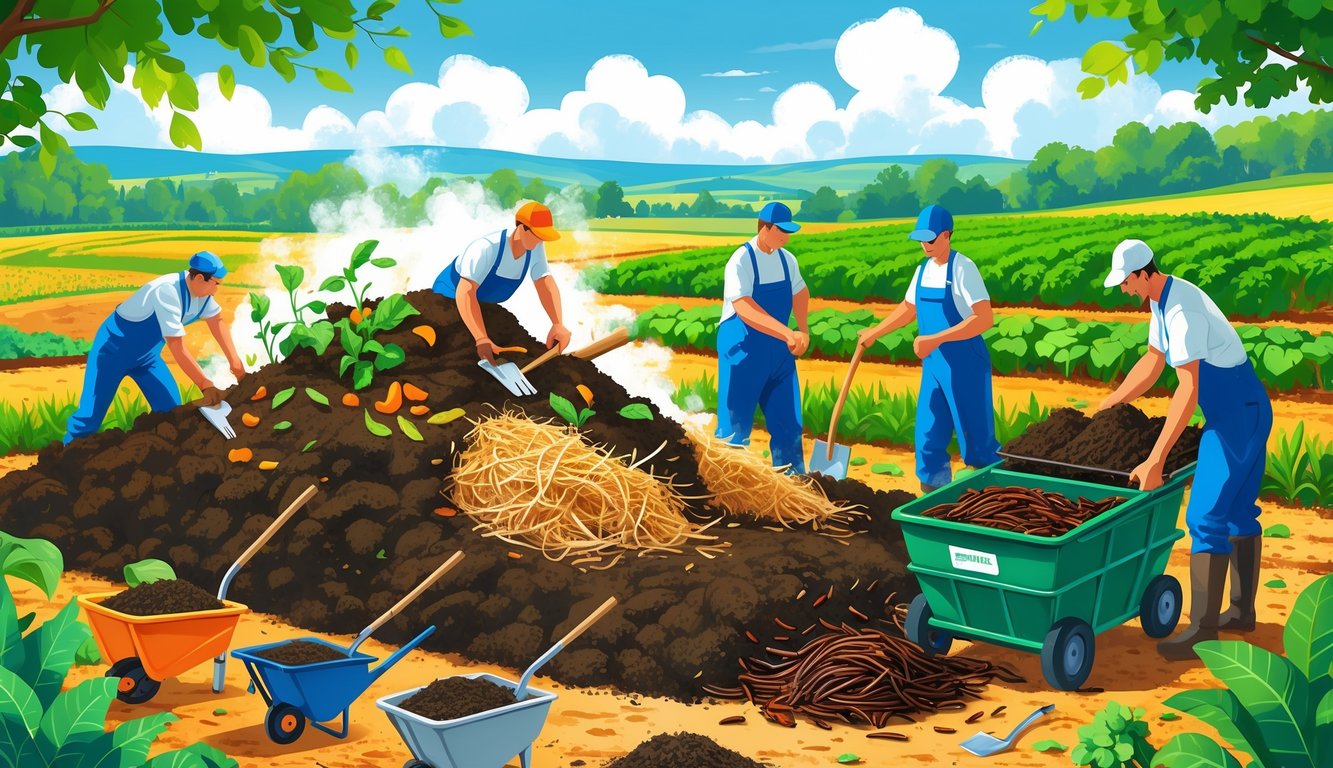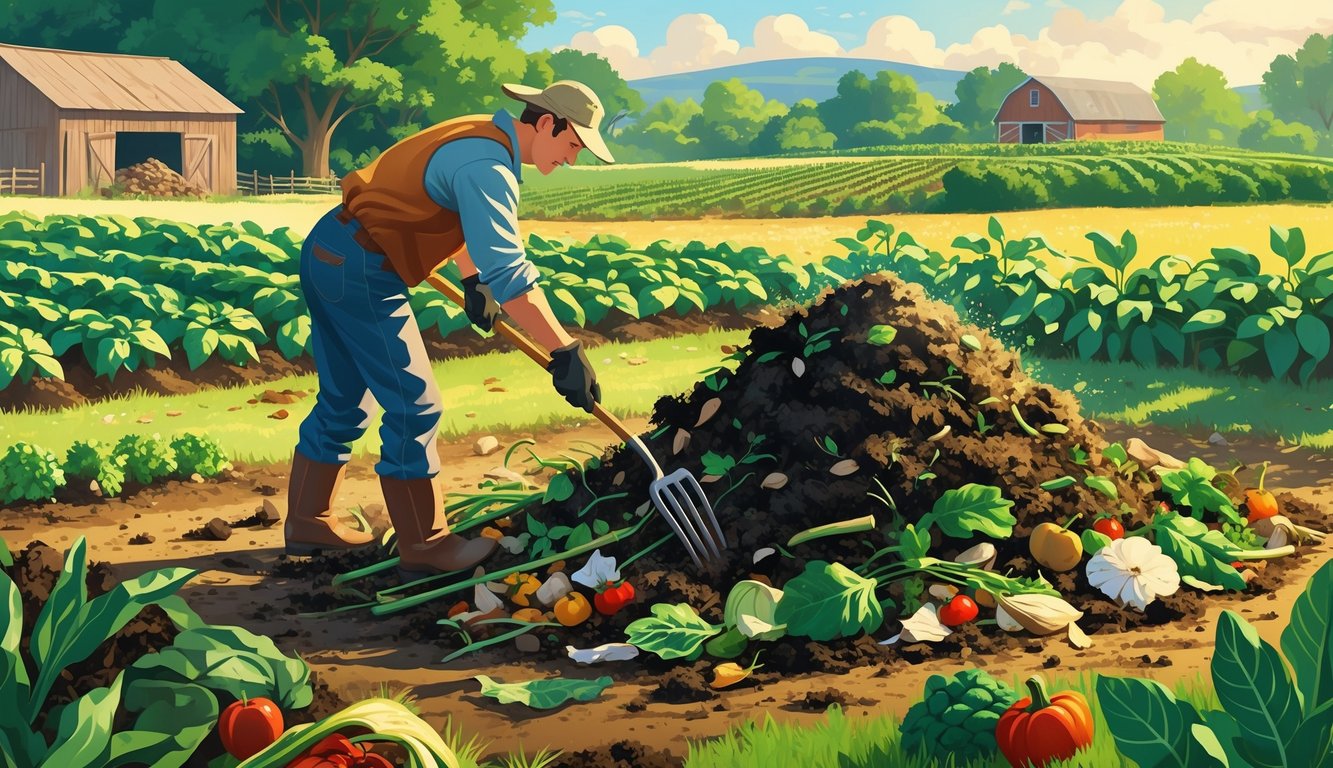
Maintaining and Troubleshooting Your Compost Pile

Honestly, what drives me up the wall: every time I try to get my compost going, it’s either freezing or sopping wet—like the universe is trolling me. Nobody’s timing this with a stopwatch, but if you want crumbly compost, you can’t ignore air and water. That’s what everyone who’s ever fought a stinky pile told me, and the research backs it up.
Turning Compost for Aeration
Shoveling the compost pile—ugh, not exactly my idea of a fun workout. But if I don’t, my whole yard reeks like ammonia and I end up apologizing to anyone who comes within ten feet. Aeration, oxygen, whatever you want to call it, that’s what it’s really about (Farming Pedia keeps repeating this like it’s a revelation). Seriously, you let the pile suffocate, and suddenly the bacteria you need just peace out, and then you’re stuck with that rotten egg smell. Try explaining that to your neighbor.
One time at a farmer’s market, this guy just tossed out, “Turn it every two weeks or when it stinks,” then wandered off like he’d solved world hunger. Helpful? Eh. Lifting wet, heavy compost chunks is a nightmare, especially when you’re thinking, “Maybe I’ll just skip it today.” Used a pitchfork for years, but recently I caved and bought one of those corkscrew aerators—Amazon’s got a million, they all look like medieval torture devices. They’re not pretty, but jabbing air holes is way easier than flipping the whole pile.
That carbon to nitrogen ratio? I’ve seen charts, I’ve ignored charts, and I still just wing it—three scoops of brown stuff (leaves, cardboard) for every scoop of green (food scraps, grass). If it stinks, I toss in more dry stuff and give it another turn. Feels like compost voodoo until you see actual steam coming up. Even Planet Natural admits turning the pile is the fix for ammonia funk or that swampy, oxygen-starved mess.
Managing Moisture Levels
Moisture is basically the composting version of Goldilocks: too wet, and it’s a swamp; too dry, and nothing happens. I’ve tried guessing with the back of my hand—never works. Once ruined a batch in November because I figured rain would handle it. Nope. If your handful drips like a squeezed sponge, you went overboard with the hose (or the weather did). Too dry? Bacteria just give up and you’re staring at the same pile for weeks. Too wet? Welcome to anaerobic sludge, which my neighbor loves to mention.
I’ve seen the pros just jam their hands in and squeeze. If barely a drop comes out, you’re golden. It’s a test I fail half the time. I try to add water slowly, mixing as I go, but who actually has the patience for that? If it’s hopeless, I just shovel on some dry leaves or cardboard, stab a bunch of holes, and walk away for a bit. Lately, even the big composting sites say the same thing—rebalance with browns, poke some air in, fluff it up until it “breathes” (Composting.io’s words, not mine).
Sometimes I’ll slap a tarp over the heap to keep the rain off, but if the wind blows it away, then everything dries out and I’m back to square one. No fancy gadgets, just endless little tweaks, muddy boots, and that squeeze test that never feels scientific.
Seasonal Composting Insights
Trying to keep compost alive in freezing weather? It’s a joke. The pile never stops steaming, just gets slushy. The bins freeze, thaw, worms vanish, and every “expert” tip overlaps but skips the parts that actually drive you nuts.
Tips for Winter Composting
All those dry leaves you hoarded in the fall? Suddenly priceless when everything ices over. I throw them in for structure—otherwise, it turns into what Arborist Now calls “winter sludge.” Sure, things slow down, but if you jab the pile with a pitchfork now and then, the microbes don’t totally give up.
Kitchen scraps rot at a snail’s pace, but layering frozen stuff with old compost keeps things insulated enough that fungi still show up. Why does snow add weight but not moisture? No clue. Sometimes the thermometer in the pile reads weirdly warm, which makes no sense. If you don’t wrap your bin, the wind just sucks out all the heat—bubble wrap, a shed, whatever you’ve got, use it.
My uncle swears his old metal drum works better if he shoves cardboard between layers. Is he making that up? Actually, Live To Plant says insulation and air keep the process chugging through winter, so maybe he’s onto something. Or maybe he’s just stubborn.
Harvesting and Using Compost Effectively
Digging through compost, I never really know when it’s “done.” If the garden fork bounces off an avocado peel, I guess it’s not ready. Most of the time, starting’s easy—it’s knowing when you’ve got that rich, finished stuff that’s tricky.
Recognizing Finished Nutrient-Rich Compost
I always thought compost would turn black and crumbly overnight. Nope. Even the farmers who deal with manure by the truckload admit you can’t trust color. If it smells earthy and not like last week’s dinner, you’re close. Penn State Extension says texture matters more—fine, soil-like, cool to the touch. Supposedly fewer weed seeds make it through that way (so they say).
Screening is non-negotiable. I use a homemade sieve—anything bigger than a bean goes back in for another round. My neighbor tried a kitchen colander once, lasted five minutes. Who has time for that? And worms? Don’t rush them. Worm compost systems crank out usable stuff in a couple months, but you have to separate the worms or you’ll be picking castings out of your onions all summer.
Applying Compost as a Soil Amendment
I dig into my beds expecting magic, but if I skip the mature compost step, it’s just blah. There’s no one-size-fits-all for adding compost, but agronomists like to say 1-2 inches spread over the beds, then mix into the top 6 inches with a broadfork. Ignore that and you’re wasting nutrients—ask me about my pumpkin patch disaster sometime.
When’s the best time? Apparently everyone argues about it. Some say fall, but honestly, I’ve seen better results in heavy clay with late winter applications, right before snowmelt. Consistency in spreading seems to matter more than the calendar. Wish someone had told me not to dump raw chunks on seedlings; finished compost actually blends in, feeds roots, helps with pH and water. For kitchen gardens, tossing a handful into each transplant hole works better than any cheap fertilizer I’ve tried. Don’t overdo it—thick layers suffocate seedlings and nutrients just wash away. Nobody brags about that.